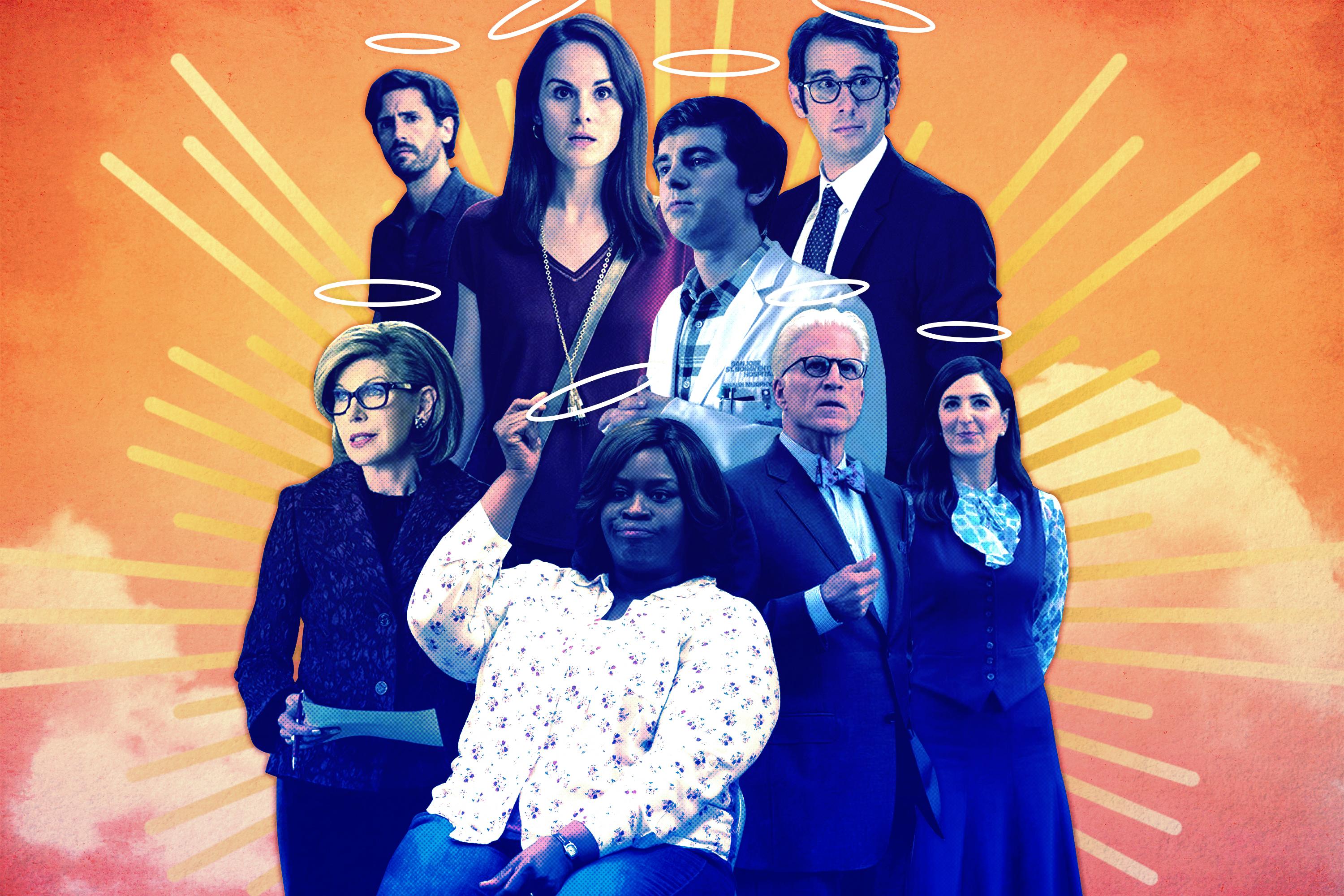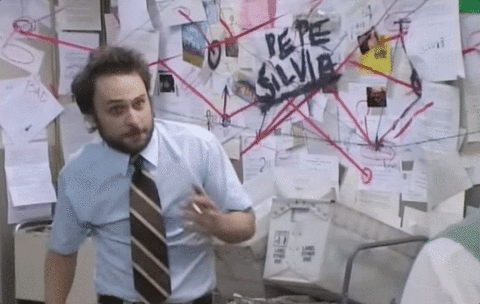
Television is such an expansive medium in 2018 that trends are bound to pop up. For instance: Assassin-dramedy is now officially a subgenre, and shows that compete in the limited-series category at the Emmys—[cough] Big Little Lies and The Alienist—can extend themselves for a second season, because if Meryl Streep wants to do television, you let her and don’t ask questions.
Most of these trends are mere happenstance; the kind of thing that occurs when more than 500 pieces of original programming are being churned out to accommodate increasingly niche viewing needs. But there is one trend that’s becoming impossible to ignore—something that is transcending quirky coincidence and coalescing into a unified theory that connects a large swath of shows across several networks. It’s high time we talk about the ever-growing Good TV Universe.
On its surface, the Good TV Universe—which comprises The Good Doctor, The Good Cop, The Good Place, The Good Fight, Good Girls, and Good Behavior—is merely a collection of shows that have “Good” in their titles, for reasons either sarcastic or surprisingly self-serious. But as I’ve come to realize, like Neo at the end of The Matrix, that’s only part of the truth. There is a Good TV world out there, one that has been growing right under our noses for years. In an era when cinema is enraptured with large-scale, interconnected cinematic universes, the best one was hiding on the small screen all along.
Come down the rabbit hole with me as I attempt to explain television’s most compelling universe in a series of smaller analyses.
A Brief History of TV’s Evolution Into Goodness
Before there was Good, there was Bad. The first golden age of television was defined by male antiheroes doing morally questionable things and being damn irresistible to watch while doing so. The OG TV bad boy was Tony Soprano, but the poster boy for this male antihero drama trend came to be Breaking Bad’s Walter White. As we witnessed Walter White transform from an anonymous high school science teacher into an odious kingpin who wouldn’t think twice about poisoning a little kid, Breaking Bad became an Emmy-winning, era-defining show. Also, it had “Bad” in the name, and that was pretty on the nose.
With apologies to The Bad Girls Club, Breaking Bad is the best show ever made with “Bad” in its title. But it may have set the bar too high for its descendents, bursting the Bad bubble in the process. While Breaking Bad inspired future male antihero imitators and even shows with taglines that intimated people were going to be Bad (like Bloodline’s “We’re not bad people, but we did a bad thing”), what followed wasn’t nearly as good (hello, Ozark!) and a proper, literal Bad Universe never fully developed. (Important note: The Bad Universe is different from the Breaking Bad Universe, which includes Better Call Saul.)
Where did all the Bad shows go? They were likely stopped in their tracks after the first extension of a potential Bad Universe was such a spectacular failure. The Kate Walsh–starring drama Bad Judge—which was about, to quote IMDb, a “hard-living, sexually unapologetic woman who plays with the law”—lasted just one season before NBC canceled it. One bad apple led to Bad TV’s ruination.
But as one TV kingdom fell, another rose in its place. The Good Wife began just a year after Breaking Bad did, and its permanence paved the way for other Good shows to arrive in its stead. It certainly helps that the post–Good Wife Good shows were actually … good shows. The CBS All Access spinoff The Good Fight somehow kept its political tension without losing its sense of fun (in The Good Fight, viewing the Trump pee tape emits a glowing golden hue from a laptop screen). This past month, The Good Place was crowned the best show on television in 2018 by TV Guide, a reward that’s hard to argue after two thrilling, twisty seasons that consider what makes a good person (or eternal being). Now the landscape is overflowing with Good shows, and just like that, the Good Universe has begun to take shape.
What Makes a Good Profession?
Like most actual human beings, the TV characters in the Good Universe have occupations that help define who they are. Let’s go through all the shows and break down what the main characters are up to:
The Good Doctor
Main Show Profession: The titular Good Doctor, Shaun, is a surgeon, and so are his doctor coworkers.
The Good Fight/Wife
Main Show Profession: Several lawyers—of varying degrees of sketchiness.
Good Girls
Main Show Profession: Thieves, who are also housewives, planning a heist to support themselves.
The Good Cop
Main Show Profession: Law enforcement.
Good Behavior
Main Show Profession(s): A hired gun and a con artist.
The Good Place
Main Show Profession: All the humans protagonists are dead and subject to the whims of eternal beings broadly defined as demons, who torture the majority of humanity except for the chosen few who can make it to the Good Place. Making it into the Good Place is virtually impossible, outside of the most virtuous human beings like the Dalai Lama and N’Golo Kanté. The demons’ main job is conjuring up new ways to torture the humans, while our human protagonists must carve out a path to salvation, lest they spend an eternity getting their skin peeled off and boiled alive.
As you can see, being broadly considered Good or being the titular Good in a Good show—in an ironic sense or otherwise—doesn’t preclude a character from any profession, or even the mortal bounds of this Earth. Heck, if ABC ordered a show called The Good Plumber tomorrow, I wouldn’t bat an eye; plumbers have been underrepresented for years! In other words: A Good TV show can be about anyone doing anything.
A Theory of Everything (Good)
Now, the first argument that an anti–Good Universe theorist will present is this: How could shows airing on CBS and CBS All Access (The Good Wife, The Good Fight), TNT (Good Behavior), NBC (Good Girls, The Good Place), ABC (The Good Doctor), and Netflix (The Good Cop) all be connected? Networks wouldn’t collaborate like this, they might add, pushing their glasses back to the brims of their noses like haters. But consider this counterpoint: There’s no evidence that proves they aren’t connected, either.
These Good shows don’t deal with a lot of overlap; the courtrooms of The Good Fight aren’t going to crossover with the chambers of an eternal, omnipotent, burrito-eating judge on The Good Place. But that doesn’t prove anything. For example, there are plenty of hospitals in America. Just because the women of Good Girls don’t stop by The Good Doctor’s hospital, doesn’t mean he doesn’t exist in the same world. While Good Girls rob a grocery store, The Good Doctor is lancing boils inside a porn star’s vagina.
Here’s the thing: These Good TV shows might be waiting for the perfect moment to announce themselves as an interconnected universe. Think about how M. Night Shyamalan made a secret sequel to Unbreakable—2016’s Split—and reverse-engineered a superhero cinematic universe that will be rounded out with a trilogy upon the release of next year’s Glass. The Good TV Universe could be waiting for a similar big reveal. And it could be coming soon.
After extensive research, I’m pretty sure it will happen like this: Christine Baranski’s Diane Lockhart will take a much-needed vacation to a Greek island, where she will inadvertently, tragically die in the middle of an elaborate song-and-dance number during which a young man flirts with her. And before Good Fight fans can even grab hold of their tissues and condemn the show for its cynical narrative decision, we see it: Diane is in a nondescript waiting room, with green letters plastered on the wallpaper reading: “Welcome! Everything is fine.” “Diane, come on in,” says Ted Danson’s Michael. Boom, Good Fight–Good Place shared universe confirmed. Rinse and repeat when The Good Doctor inadvertently kills a patient, or the hitman of Good Behavior murders someone, and you’ve got a through line to connect all these shows in the afterlife. Whenever Good shows want to shake things up with a character death, they’re sent to The Good Place—even if, technically, they’re going to the Bad Place. (I’m looking at you, the Good Doctor; you’re not fooling me.) There, now you see. With the connected Good Universe expertly, unequivocally established, let us move on.
A Scale From Good to Good
Not all Goods have been created equal. TNT’s series might be named Good Behavior, but seeing that the show follows the complicated relationship between a hitman and a con artist, it is about the opposite of good behavior. (Nice one, guys!) Conversely, in Netflix’s The Good Cop, Josh Groban plays a virtuous, wholesome cop; no strings attached. In that case, the title can be taken at face value.
Thus, there is a Good scale to consider in the Good TV Universe, from the earnest to the sarcastic. Here is how the shows break down, from Legit Good to Bad Good.
Legit Good
The Good Cop: Again, it’s about a very wholesome cop (Groban). The tension derives from the good cop’s contrast with his father, played by Tony Danza, who had a reputation for being a bad cop. But since the title refers to the son, this is Legit Good.
The Good Doctor: Freddie Highmore’s Shaun might not always know the best way to approach and talk to people, but at its core this very good doctor is all about saving lives in ingenious ways; with any luck, he might also score a date with his attractive neighbor who really likes to play video games.
Lukewarm Good
The Good Place: This is a tough one, because the humans and the immortal beings at the center of the show evolve throughout, from self-centered jerks to people who want to be better. It’s the best of both Good worlds, really.
The Good Fight/Wife: There are public sex scandals and heady slaps to the face, but also lawyers occasionally doing good things in court. This falls squarely in the middle.
Bad Good
Good Girls: The Good Girls—played by Christina Hendricks, Retta, and Mae Whitman—have the right intentions for planning a heist, but the fact of the matter is that robbery is still illegal and generally frowned upon! This isn’t like the upcoming Steve McQueen movie Widows, where Viola Davis has to pull off a heist because Paper Boi from Atlanta is threatening to kill her. This is just three bored people trying to reassert their agency and make a quick buck. You can do that in less illicit ways, I’m sorry!
Good Behavior: There is plenty of sex appeal in Good Behavior, but also plenty of murder. This is clearly Bad Good.
The Future of Good Shows, and My Existential Breakdown
The Good TV Universe shows no immediate signs of slowing down. Post–Good Wife, here’s how it’s looking: As The Good Place and The Good Fight gear up for their third seasons, The Good Doctor just began its second season after becoming a ginormous ratings hit for ABC, Good Girls was renewed for a second season, and The Good Cop dropped on Netflix just this month. The only Good show in flux is Good Behavior, which TNT is mulling over whether to provide a “final chapter” for after two seasons with tepid ratings.
Still, six solid Good shows out of seven is a very high success rate—compare that with the early films of the Marvel Cinematic Universe (remember Edward Norton’s Hulk?). What success means, of course, is expansion.
Next year, we’ll get an eighth Good show: Good Trouble, on Freeform. Good Trouble is going to be a spinoff of The Fosters, which opens a Pandora’s box. It’s a spinoff of a show that isn’t tied to the Good Universe, but since it has Good in the name, is The Fosters also part of the Good Universe? Is Noah Centineo now Good Universe canon? If shows that don’t have “Good” in their title can be part of the Good Universe, what’s to stop other non-Good shows from joining it? What if this goes all the way to the top?
It’s a lot to think about, I know. Until further research is conducted, we can’t leave anything to chance: We can assume only that every scripted show on television is part of the expansive Good TV Universe. Here, want to see my vision board?

Westeros is a fictitious fantasy world concocted by someone undergoing a hallucinogenic drug trial in New York City. And what about the Upside Down of Stranger Things? Great question: That was taking place in the past, before all other Good TV shows began their timelines; plus, none of the Good shows take place in Indiana, anyway. The Walking Dead’s zombie apocalypse? I hate to break it to you, but Rick Grimes is still in a coma—and the Good Doctor is working on a solution so he can once again be a Good Cop and eat pudding with his son.
It all makes sense, really: Television has become an ouroboros of Goodness, swallowing itself in an endless cycle of Good-based programming after a brief stint of trying to break Bad. There is no way to break the Good cycle; we must simply enjoy all the Good stuff that is being provided to us on an infinite loop. Welcome! Everything is fine.

